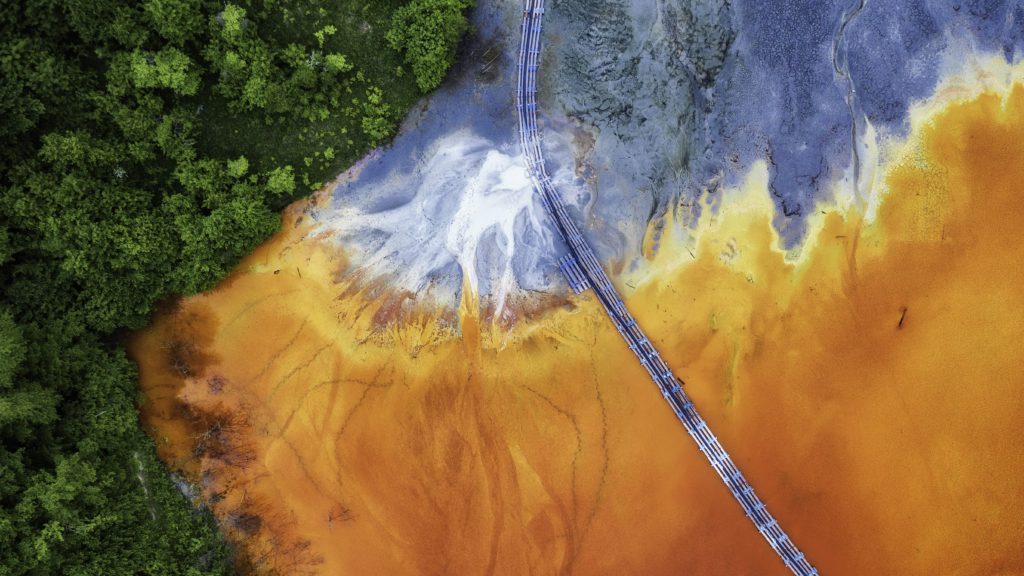
Geamana village in Romania flooded with waste water from mining, 2019 (Stock Image)
(The opinions expressed here are those of the author, Andy Home, a columnist for Reuters.)
Protesters took to the streets in Serbia again on Saturday. It was the third consecutive weekend of marches and road blockades against the government’s push to develop its mining sector.
In Portugal’s Serra d’Arga mountains lithium is also the target of environmental resistance, with five local mayors leading a demonstration in October to protest against a mining project.
Opponents of the proposed Rovina Valley copper mine in Romania have gone a step further, buying parcels of land “strategically located” within the project development area, according to Mining Watch Romania.
There are 19 metal “mining conflicts” in the European Union (EU), which does not include Balkan states such as Serbia, a research paper published last year by the Geographical Society of Finland said.
It’s a big problem, given Europe’s Green Deal will be driven by metals such as lithium and copper and policy-makers want more of them to be produced locally.
Green credentials?
The European Commission has placed sustainable and responsible extraction at the heart of the bloc’s green minerals policy.
However, Europe’s environmental credentials came in for some sharp criticism at a Dec. 2 public hearing of the European Parliament.
The claim in a Nov. 24 parliamentary resolution on critical materials that mining in the EU is subject to the highest environmental and social standards “is not true in theory and it is not true in fact,” Dr Steven H. Emerman said.
Dr Emerman is not your typical eco-warrior. He is a geophysics expert with qualifications from Princeton and Cornell Universities, 31 years teaching experience and 70 peer-reviewed publications.
He also chairs the Body of Knowledge Subcommittee of the U.S. Society on Dams and has formidable expertise on tailings dams, where mine waste is stored.
His testimony to the hearing cited several instances of suboptimal dam maintenance and planning.
The risk of failure at a saturated dam in Spain is “equivalent to an annual round of Russian roulette,” he said.
A lithium mine project in Portugal includes a design for a 193-metre high tailings dam that is “highly experimental” and an example of “reckless creativity”.
A copper project in Spain plans an 81-metre high dam located on a steep slope at less than 200 metres above a village. That would be illegal in Brazil, Ecuador and even China, which stipulates a one-kilometre gap between a tailings dam and a population centre, Dr Emerman said.
“I have not said one word against mining,” he told the hearing, but warned European policy-makers not to rush into opening new mines “without a convincing demonstration that there will be no adverse impacts on human life or the environment”.
Waste management
Although the EU has publicly committed to a clean mining sector, the process of aligning regulations across 27 countries is painfully slow versus the breakneck stampede to invest in critical mineral supply chains.
The EU adopted the Mineral Waste Directive in 2006 after tailings dam failures in Spain in 1998 and in Romania two years later.
Its 2017 progress report found that as of November 2016 four member states had yet to correctly transpose the directive onto their statute books, the reporting system wasn’t fit for purpose and there were no guidelines on inspections.
The technical guidelines on inspections have since been introduced but only last year.
Mining and quarrying are the second largest source of waste in the European Union after construction, accounting for 26.3% in 2018. Most is stored in some form of storage ponds or tailings dams, the most visible reminder that mining is a dirty business.
And a potentially fatal one. Public perceptions of mining have been shaped by the devastating 2015 and 2019 tailings dam failures in Brazil.
The problem is compounded by old, abandoned mine sites leaking contaminated water into the local eco-system, each of them adding fuel to the eco-warrior fires.
Squaring the green circle
How to square the circle of needing more green metals and assuaging growing green opposition to mining those metals?
As a matter of urgency, the EU should accelerate the full implementation of its own mining waste directive.
If it is to boast about its green mining credentials, they must bear scrutiny.
Tailings dams, existing and planned, should be studied with particular care. A tailings dam failure on home turf would be a hammer-blow for both Europe’s mining sector and policy-makers.
Europe could also consider following the lead of the United States, which has directed the United States Geological Society to map and collect data on mine waste.
This serves the double purpose of identifying sites in need of remediation and unearthing potential mineral riches.
Tailings are full of elements once deemed worthless by-products and now on the critical minerals list. Even current tailings dams may contain minerals not yet considered essential but which might one day be so.
Exploiting such urban mines, however, is unlikely to be commercially viable if it is conditional on long-term stewardship of the site, which may include reconstructing unsafe dams and an extensive clean-up of the surrounding area.
The EU is spending cash on stimulating investment in new mining and processing capacity. It could usefully channel some of that into old mine sites.
Apart from the chance of discovering useful metals, restoring the sites could help remove some of the unhelpful reminders of the industry’s contaminated legacy.
New European mines could come with a government-backed quid pro quo of cleaning up abandoned sites and ensuring the long-term stewardship of any waste storage facilities.
If the EU is going to persuade its citizens of its green credentials, policy-makers may have to roll up their sleeves and get into the dirty side of mining.
(Editing by Barbara Lewis)
No comments:
Post a Comment